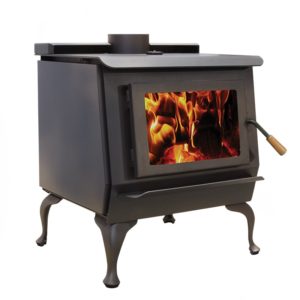A power outage could leave you shivering at any time of the year. That’s why investing in an alternative heating source is critical.
In the past, many homes relied on wood-burning fireplaces and stoves, but strict regulations are making this approach less feasible.
Subsequently, the search for an indoor non-electric heater is more challenging than ever before.
We’ve spent hours researching possible alternatives to electric heaters, scrutinizing their product descriptions, and assessing their safety, legality, cost, and convenience.
After all that, we finally found six heaters we feel comfortable recommending.
Best Indoor Non-Electric Heaters Reviewed
#1 Dyna-Glo Kerosene Forced Air Heater
This cost-effective kerosene heater produces up to 50,000 BTU, making it more capable than any other non-electric heater. It can heat a standard-sized garage, or workshop, in a matter of minutes and keep it warm for up to 14 hours.
When exploring the pros and cons of kerosene vs. propane heaters, we touched on the subject of the comparative cost per BTU of energy.
Using that calculation, we figured out that this kerosene heater is slightly cheaper to run than our number two propane pick. We based those calculations on the current fuel prices, which are liable to fluctuate.
Cost Comparison per BTU: Kerosene vs. Propane
| Fuel Type: | Kerosene | Propane |
|---|---|---|
| Average price per gallon
(as of 03/16/2022): |
$4.13 | $4.58 |
| Potential Energy in BTU | 135,000 | 91,333 |
| Divided by BTU: | $0.00003 | $0.00005 |
| Cost per BTU: | $0.03 | $0.05 |
Unfortunately, the initial outlay is higher, and you should expect to pay around three times the price of a good-quality propane heater.
On the plus side, kerosene is a clean fuel that’s easy to source and buy, which makes up for the additional maintenance needed to keep this unit operating smoothly.
Simple to use, the indoor heater distributes heat quickly and features several safety mechanisms, including a flameout sensor and run-time fuel gauge.
Pros:
- Powerful and energy-efficient
- Fuel is widely available and cost-effective
Cons:
- Comparatively expensive to purchase
- Requires more maintenance than other heaters
#2 Mr. Heater Buddy Indoor-Safe Portable Propane Heater
This energy-efficient propane appliance nearly snatched the number-one slot and is still a great option. Unfortunately, the lower energy efficiency and higher running costs let it down.
Unlike some propane heaters, this one is approved for internal use and has several safety features, including an automatic shut-off that kicks in if the pilot light goes out, in-built sensors detect low oxygen levels, or the unit is knocked over.
This portable heater is nearly 100% energy efficient. On a 1lb can of propane, it can run continuously for up to three hours when operating at maximum power.
It will heat a room in less than 15 minutes and produce 9,000 units of thermal energy, or British Thermal Units (BTU), per hour.
With no installation required, you can be up and running in a matter of minutes. Simply turn the dial to pilot and push to ignite.
Pros:
- Affordable
- Energy-efficient
Cons:
- Running costs higher than with a kerosene heater
- Faulty pilot light reported on some units
#3 Mr. Heater Big Maxx Natural Gas Unit Heater
This natural gas heater is dependable and economical. It can produce up to 20,000 BTU/hr of thermal energy, making it powerful enough to heat a room of up to 700 sq. ft.
With its battery-run igniter, it’s simple to operate and is portable enough that you can move it from room to room rather than heating your entire home.
Safety mechanisms include an oxygen depletion sensor that will shut the unit down as soon as it detects a lack of oxygen or dangerous levels of carbon monoxide.
Despite its versatility, it isn’t suitable for smaller rooms or homes as the lack of ventilation will cause a potentially dangerous build-up of carbon monoxide that will, in turn, cause the heater to shut off. (
Safety Note: Always have a working carbon monoxide monitor.
Although the purchase price is higher than that of a propane or kerosene heater, the cost of gas makes it cheaper to run, so you can quickly offset that initial outlay.
On the downside, a gas heater requires regular maintenance to keep it operating safely and effectively. It’s also unsightly, making it more suited to heating a garage than a living room.
Pros:
- Economical to run
- Simple to operate
Cons:
- Not suitable for small spaces
- Presents potential danger of carbon monoxide build-up
#4 Arctic Solar 1500 Series, Gen 2 Solar Air Heater
Solar air heaters don’t come cheap but, as they have zero running costs, you can quickly redeem that initial investment.
While efficient, they require at least partial sunlight to operate, which means you’ll only be able to heat your home during the day.
Designed more as a supplementary heat source rather than a stand-alone heater, a solar air heater, a solar air heater is better used as one of several emergency heating options.
Unlike fuel-based units, installing the Arctic solar air heater will require some technical know-how. Once installed, however, it is powerful enough to heat 150 sq. feet of space at no cost at all.
A solar air heater works by using a solar-powered fan to draw cool interior air into collector cells that are heated by the sun’s infrared energy. As the air passes through those collector cells, it retains that heat. On a warm day, this can increase the ambient temperature by up to 20℉.
Pros:
- Zero running costs
- No fuel sourcing or purchasing required
Cons:
- Only works during daylight hours
- Can only heat up to 150 sq. feet of space
#5 Regal Flame Venice 32″ Ventless Bio Ethanol Fireplace
By burning bioethanol fuel, this fireplace manages to be clean, efficient, and cost-effective. While you’d be better off leaving the installation to an expert, the unit is easy to clean and maintain.
It produces 6,000 BTU of thermal energy and can run for up to eight hours on a medium setting.
It gives the ambiance of a wood-burning stove without requiring daily cleaning. It also eliminates the nuisance of sourcing, buying, and storing wood.
Surprisingly affordable given its appearance and durability, the running costs can add up, especially if the slider is fully open for maximum warmth. Sub-standard fuel will also cause your daily expenses to soar, so sourcing high-quality bioethanol is essential.
Pros:
- Easy to clean and maintain
- Environmentally friendly
Cons:
- High running costs
- May require professional installation
#6 Blaze King Princess 32 Wood-Burning Stove
In terms of ambiance and appearance, a traditional wood-burning stove is hard to beat. Although this model’s efficiency and minimal emissions make it more attractive than older models, it still has numerous downfalls.

The purchase price, for one, is staggeringly high, while installation is both complex and potentially disruptive.
Once in place, you still have to source and purchase firewood, get it delivered, and find somewhere to store it. Not only is that time-consuming, but it’s also expensive.
The Princess 32 meets all the legal requirements introduced by the US Environmental Protection Agency (EPA) and does an impressive job of keeping emissions to a minimum.
Producing just 0.4 grams of smoke per hour, it’s well below the required levels. This also means it burns more conservatively than other, less-efficient wood burners. As a result, it can produce 30 hours of constant heat on its lowest setting and 10 hours at full blast.
Capable of producing over 30,000 BPU, it’s by far the most powerful indoor heater on our list, but only 80% energy efficient.
Pros:
- Can produce 37,727 BPU
- Capable of delivering 30 hours of constant heat
Cons:
- Requires daily cleaning and maintenance
- Costly to purchase and run
How To Find The Best Indoor Non-Electric Heater For Your Needs
Having performed our in-depth research into the best non-electric heaters for your home, we suggest prioritizing the following six elements in your search for the perfect heating unit:
#1 Purchase Price
The price of interior non-electric heaters ranges from a few hundred dollars to several thousand so, your budget will have a significant impact on the options available. Unless you’ve got money to burn, investing in a wood-burning stove is uneconomical, especially when you consider the hefty running costs.
On the other hand, shelling out a large lump sum on a solar air heater could make sense if you have the climate necessary to offset that investment relatively quickly.
#2 Running Costs
There’s little point in buying a cheap interior non-electric heater if the running costs will bankrupt you in a matter of months. Of course, this is less of an issue if you’re simply looking for an emergency heating backup, but if you’re planning on running the heater all winter, you want something economical.
Natural gas and kerosene are cheaper per BTU than propane, so are well worth considering if you want more hours of constant heat.
If you want a non-electric heater to offset the cost of heating your home, a solar air heater might be worthwhile, although a wood-burning stove is probably your best option in these circumstances.
#3 Energy Efficiency
The higher your heater’s energy efficiency, the less money you waste. A product that operates on 100% efficiency produces heat from every gram or ml of fuel you purchase, making it the most cost-effective.
An energy-efficient heater will burn clean, produce fewer emissions, and reduce your environmental impact and carbon footprint.
While solar is the most environmentally friendly alternative to electric heating, it’s not the most consistent or viable. Opting for a high-quality, energy-efficient propane heater is probably your best option.
#4 Fuel Cost and Availability
The best indoor heaters run on fuel that is widely available and easily accessible. Using propane, kerosene, or natural gas will reduce transportation costs and alleviate potential storage problems. Wood is heavy and bulky which makes it the least practical and cost-effective.
Kerosene, on the other hand, is widely available and affordable. Both propane and ethanol are relatively easy to source and won’t cost you an arm and a leg. Of course, sunlight is ubiquitous, especially in the summer, but a solar air heater won’t be much good if you’re hunkered down in Washington State or Buffalo, where the sun only shines for around 52 days a year.
#5 Power and Heating Capacity
If you only want a non-electric heater to warm your house in an emergency or when there’s a major power outage, you can get by on something less powerful. A standard propane heater, for instance, can only heat around 225 square feet for up to three hours but, as it’s portable, is more than sufficient for emergency use.
Read:
A wood-burning stove, on the other hand, is designed to heat your entire house, but can’t do it fast enough to be considered a viable emergency heating option.
#6 Intended Purpose
Before you invest in an indoor non-electric heater, think about what you need it for. If you’re trying to get off-grid and want a reliable source of heat throughout the year, it’s worth investing in a good-quality kerosene heater.
If, on the other hand, you want a backup heat source to use in emergencies, a propane heater might be a more suitable and cost-effective option.
Conclusion
Figuring out which is the best indoor non-electric heater largely depends on what you plan on using it for. Overall, a high-quality kerosene heater, like the one from Dyna-Glo offers the best value for money. It also uses a widely available fuel source and produces enough constant heat to warm a large room or garage.
On the other hand, a propane heater is most suitable for smaller homes and as an emergency heating source.
Regardless of which indoor non-electric heater you decide to invest in, be sure to consider its impact on the environment, as well as your wallet.




